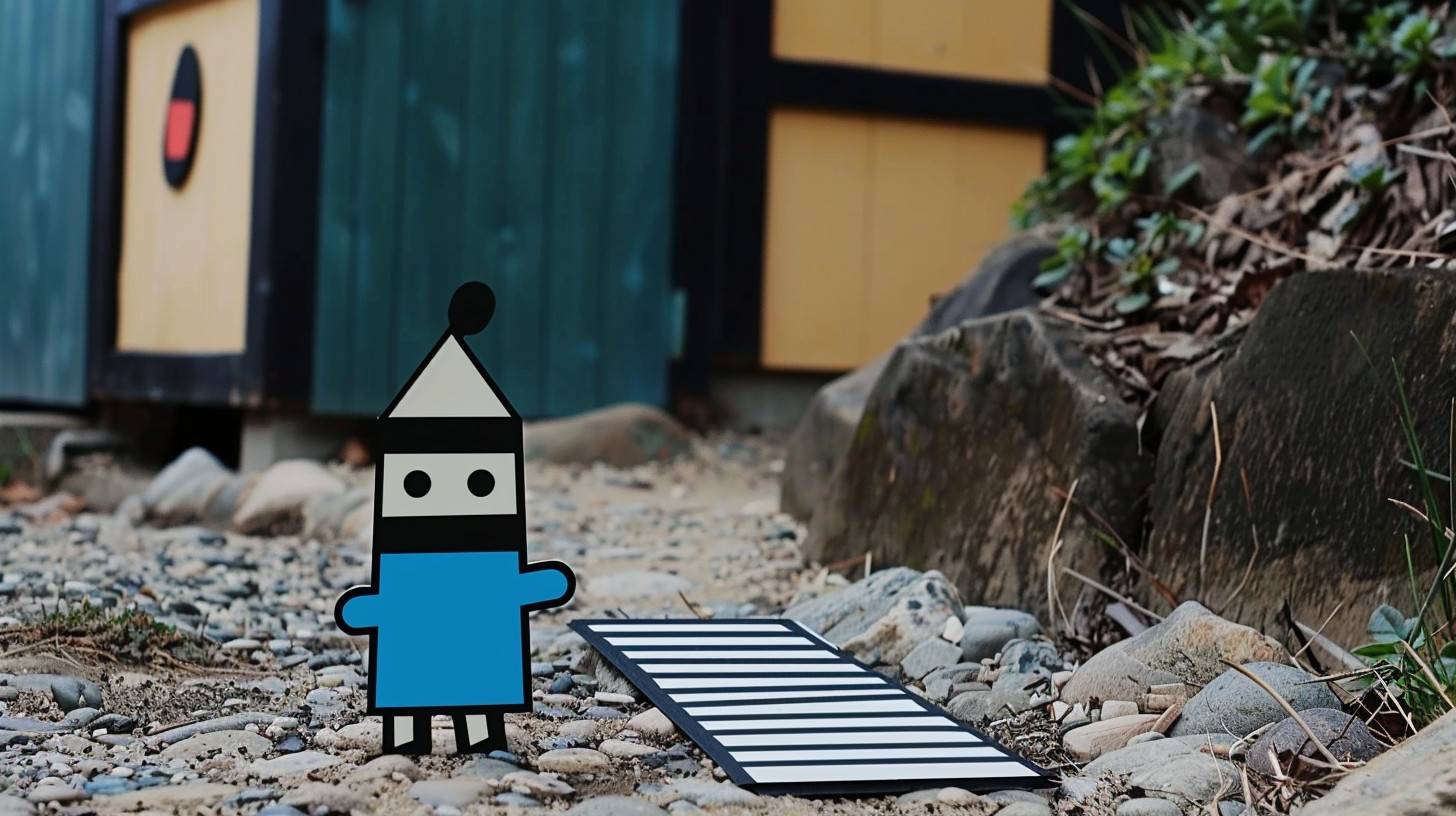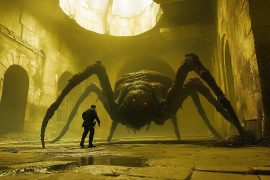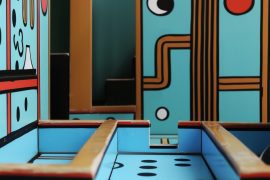I was seven years old when I first met Mario, though neither of us knew we’d be lifelong companions. It was Christmas 1985, and that Nintendo Entertainment System—acquired through my dad’s night shifts and overtime—came bundled with Super Mario Bros. I still remember that first descent down a green pipe, the discovery of an underground coin heaven, and the startled joy of finding out you could actually go backwards in a video game level. What I didn’t know then, as I sat cross-legged in front of our wood-paneled Zenith TV, was that I was experiencing the work of a creative genius who would shape not just my gaming habits, but my understanding of joy, discovery, and design for decades to come.

Shigeru Miyamoto didn’t just make games; he created worlds that felt like they existed when you weren’t looking. The Mushroom Kingdom, Hyrule, Donkey Kong Island—these weren’t just backdrops for jumping or sword-swinging; they were places with their own internal logic, secrets, and delights. The Miyamoto design philosophy player experience approach revolutionized what games could be, shifting focus from high scores and completion to the moment-to-moment joy of play itself. While other designers built obstacle courses, Miyamoto built playgrounds—spaces designed not just to challenge but to delight.
This philosophy reveals itself most clearly in Mario level design teaching mechanics, where complex ideas are introduced without a single word of instruction. World 1-1 of Super Mario Bros. is essentially a masterclass in game literacy, teaching you everything you need to know through careful placement of elements. That first Goomba, positioned so you almost certainly bump into it on your first playthrough, teaches death and consequence. The first question mark block, positioned temptingly overhead, teaches interaction and reward. By the time you reach the first pit, you’ve been silently trained in the core mechanics needed to avoid it. It’s brilliant, invisible teaching.
I remember showing Super Mario Bros. to my nephew Jake about fifteen years ago, when he was just five. I handed him the controller without explanation, curious if Miyamoto’s design would still work its magic on a child raised with modern games. Sure enough, within minutes, Jake had figured out running, jumping, and the basic goal without a word from me. By the time he reached World 1-2, he was discovering secrets on his own, yelping with delight when he broke through the ceiling to find the warp zone. “How did you know to check there?” I asked. He shrugged. “Just seemed like something might be there.” That’s the genius of Miyamoto—he doesn’t just create games; he creates curiosity.
The Zelda puzzle design discovery satisfaction loop represents another facet of Miyamoto’s brilliance. The moment in the original Legend of Zelda when you first burn a bush with your candle to reveal a hidden cave entrance. The realization in A Link to the Past that the dark world mirrors but transforms the light world. The first time you put on the Deku Mask in Majora’s Mask and feel your entire relationship with the game world change. These aren’t just clever game moments; they’re epiphanies—small but meaningful discoveries that trigger genuine eureka moments in the player’s mind.
My college roommate Tom and I spent an entire weekend making our way through Ocarina of Time, taking turns with the controller while the other consulted the strategy guide (only for emergencies, we promised ourselves). When we finally figured out the Water Temple—that infamous, maddening, brilliant level design puzzle box—we actually high-fived like we’d solved some great mystery of the universe. And in a sense, we had. Miyamoto’s puzzles aren’t just obstacles; they’re invitations to think differently, to see the world from new angles, to question your assumptions about how things work.
The Miyamoto garden inspiration game concepts story is well-known but worth reflecting on. His childhood experiences exploring caves, finding secret lakes, and getting lost in forests directly informed the sense of wonder and discovery in his games. The original Legend of Zelda was born from his memories of wandering the countryside, finding new paths and secret places. Pikmin emerged from watching ants in his garden, imagining their tiny perspective on the world. This childhood wonder permeates his work, making his games feel less like designed products and more like natural discoveries.
You can see this particularly in the Pikmin series, where the familiar becomes fantastical through a shift in perspective. I remember the first time I played the original Pikmin, marveling at how Miyamoto had transformed mundane objects—bottle caps, batteries, fruit—into mysterious artifacts in a miniaturized world. The garden behind my apartment suddenly seemed like it might hide tiny adventures I couldn’t see. That’s what Miyamoto does best—he doesn’t just transport you to fantasy worlds; he makes you see the potential for magic in your everyday surroundings.
The Nintendo polish Miyamoto standards are legendary within the industry. There’s a reason “Nintendo polish” is shorthand for that ineffable quality of just-rightness in game feel. The precise arc of Mario’s jump—not too floaty, not too heavy. The satisfying “click” when a puzzle piece falls into place in a Zelda dungeon. The way Link’s sword strikes feel powerful without being unwieldy. These details aren’t accidental; they’re the result of Miyamoto’s famous iterative approach, tweaking and refining until the experience feels natural, intuitive, joyful.
I’ve played plenty of platformers over the years, but nothing quite feels like controlling Mario. There’s a precision there, a responsiveness that makes you feel like an extension of the game rather than someone struggling against it. After a long session with a Mario game, I often find myself bringing that same expectation to other games and feeling vaguely disappointed when they don’t quite match up. “It’s good,” I’ll think, “but it doesn’t have that Miyamoto feel.” I couldn’t articulate exactly what that meant for years, until I read an interview where Miyamoto explained his philosophy that a game should never punish a player for something that isn’t their fault. That perfect control, that sense that every failure is a learning opportunity rather than a frustration—that’s the Miyamoto standard.
Perhaps his most influential achievement was the Miyamoto transition 2D 3D pioneering work in the mid-90s. When the industry was struggling to translate beloved franchises into three dimensions, Miyamoto didn’t just succeed—he wrote the rulebook that others would follow for decades. Super Mario 64’s 3D movement and camera controls established conventions that still underpin 3D gaming today. The Z-targeting system in Ocarina of Time solved the fundamental problem of precision in 3D space, becoming so ubiquitous that modern gamers don’t even realize it was once a revolutionary innovation.
I still remember my first time playing Super Mario 64 at a mall kiosk before the N64 launched. A small crowd had gathered, watching as I figured out the controls. When I discovered you could make Mario do a triple jump, there was an audible gasp from the onlookers. It felt like witnessing a magic trick. The freedom of movement, the camera control, the joyful responsiveness of Mario in 3D space—it was a paradigm shift. I went home and looked at my SNES with different eyes, suddenly aware that a fundamental change had occurred in what games could be.
The Miyamoto character design iconic simplicity approach has created some of the most recognizable figures in pop culture. Mario’s mustache and cap, originally design solutions to pixel limitations, became signature elements of gaming’s most famous mascot. Link’s green tunic and pointed hat instantly communicate “hero of legend” without a word. Even secondary characters like Toad, Bowser, and Ganondorf are immediately distinctive, their silhouettes alone enough to identify them.
This approach extends beyond aesthetics into character functionality. Each character in a Miyamoto game feels distinct in how they move and interact with the world. Playing as Luigi in Mario games isn’t just a palette swap—he jumps higher, has more momentum, feels different under your control. Different masks in Majora’s Mask fundamentally transform how you navigate and perceive the game world. These aren’t just visual differences; they’re experiential ones, changing your relationship with the game space.
The Miyamoto hardware software integration philosophy has produced some of gaming’s most innovative experiences. Where some designers create games that could theoretically exist on any platform, Miyamoto designs for the unique capabilities of Nintendo’s hardware. The DS stylus controls in The Legend of Zelda: Phantom Hourglass. The motion controls in Wii Sports. The dual-screen puzzle elements in various Mario and Zelda titles. These aren’t gimmicks tacked onto existing game structures; they’re experiences built from the ground up to leverage specific hardware features in ways that feel natural and enhancing.
I was initially skeptical about the Wii Remote when Nintendo first unveiled it. It seemed like a novelty that would quickly wear thin. Then I played Wii Sports bowling with my parents—who had never shown interest in video games before—and watched as they intuitively understood how to play without tutorials or explanation. My mom, who still calls every console a “Nintendo” regardless of manufacturer, was suddenly developing her own bowling technique, adjusting her throw based on previous results. That’s when I understood what Miyamoto was doing—using hardware innovation to broaden what games could be and who could enjoy them.
The Miyamoto playful experimentation approach is perhaps his most enduring legacy. Despite his legendary status, there’s a sense that Miyamoto approaches each project with childlike curiosity rather than the burden of his own reputation. Pikmin, a completely new IP introduced decades into his career, demonstrates his willingness to explore new ideas. Nintendo Labo, with its cardboard construction toys integrated with the Switch, shows his continued interest in redefining what games can be. This willingness to try, fail, learn, and surprise has kept his work fresh through decades of industry changes.
I remember bringing Nintendo Labo home, somewhat doubtful that cardboard contraptions could really deliver a meaningful gaming experience. Three hours later, my living room was covered in cardboard scraps as I marveled at the fishing rod I’d constructed, which somehow translated my physical movements into in-game actions with remarkable precision. That same childlike delight I’d felt discovering secret areas in The Legend of Zelda as a kid was back, only now it bridged digital and physical play in ways I hadn’t imagined possible.
Miyamoto’s influence extends far beyond his own games. Every indie platformer with carefully considered level design owes something to Mario. Every open-world game that trusts players to explore at their own pace carries Zelda’s DNA. The entire concept of 3D action-adventure games was defined by his 90s work. But beyond these technical influences, Miyamoto’s greatest legacy might be his insistence that games should be joyful, accessible experiences that nonetheless contain depth for those willing to look deeper.
As I’ve grown older (and balder), I find myself returning to Miyamoto’s games not just for nostalgia but for the genuine pleasure they still provide. There’s a timelessness to their design that transcends technological limitations. I can play through Super Mario World today and still find it satisfying in a way many modern games with vastly superior technology fail to match. That’s because Miyamoto has never designed for technology—he designs for human experience, for the smile that comes from perfectly timing a jump, for the satisfaction of solving a clever puzzle, for the wonder of discovering something hidden just off the beaten path.
When my friend’s daughter became old enough to hold a controller, I didn’t hesitate to introduce her to Mario Kart 8 rather than whatever was trending on mobile app stores. Within minutes, she was laughing with delight as she sent green shells spinning across Rainbow Road. “It’s like the game is playing with me, not just me playing the game,” she said, unknowingly echoing what critics and designers have been saying about Miyamoto’s work for decades. His games don’t just entertain; they communicate, they respond, they surprise and delight in ways that feel almost like conversation with a playful friend.
In an industry often obsessed with photorealism, massive scale, and complex systems, Miyamoto reminds us that the heart of gaming isn’t technological achievement but human joy. His greatest creation isn’t Mario or Zelda or any specific game mechanic—it’s the understanding that play itself is valuable, that curiosity deserves reward, that games can speak to the child in all of us while respecting our intelligence. Decades after I first went down that green pipe, I’m still discovering the depth of that lesson, and still grateful for the worlds he’s invited us to play in.





